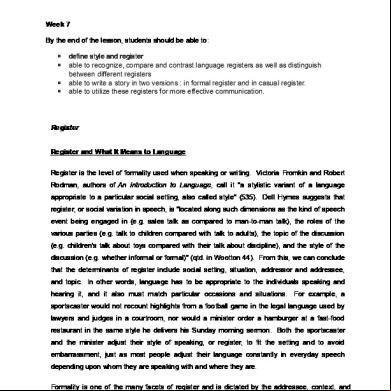Constellation m3h6q
This document was ed by and they confirmed that they have the permission to share it. If you are author or own the copyright of this book, please report to us by using this report form. Report 2z6p3t
Overview 5o1f4z
& View Constellation as PDF for free.
More details 6z3438
- Words: 1,048
- Pages: 7
Constellation What are constellations ? 1. We can see millions of stars in the sky at night . 2. A group of stars can form a pattern . 3. The pattern formed by a group of stars is called a constellation . 4. Examples of constellations are … * Big Dipper * Southern Cross * Orion * Scorpion 5. The following table shows The information the Constella Pattern times about The constellations . tion when these direction constellatio n
shown the constellati ons
Big Dipper
A bowl with a handle
April to June, North Pole around 8 p.m. to 10 p.m.
Southern Cross
A cross
April to June, South Pole around 8 p.m. to 10 p.m.
Orion
A hunter with a belt and a sword
December to February
Scorpion
North Pole
A scorpion June to ~ withare a head, 6. The following the uses August, of constellation : long body, tail around 8 p.m. (a) To show direction stingof the time to 10for p.m. (b) To remindand farmers harvesting and plantin
Constellation during Spring
Leo, the Lion The zodiacal constellation Leo, the lion, is one of a handful of constellations that really does look like its namesake. Look for Leo high in south in April and May. Leo's brightest star is blue-white Regulus, one of the brightest stars in the night sky. Regulus rises almost due east, with the body of the lion following it into the sky over the next couple of hours. Once Regulus climbs into the sky, look to its left — toward the north — for a group of stars forming a backward question mark. These stars outline Leo's head and mane. About two hours later, look low in the east for Leo's tail — a white star named Denebola — an Arabic name that, appropriately enough, means "tail of the lion."
Cygnus, the Swan The brightest stars of Cygnus form a cross, so the swan is also known as the Northern Cross. Find it soaring high overhead during late summer evenings. The constellation's brightest star is Deneb — an Arabic word that means "the tail." Deneb — the tail of the swan — marks the top of the cross. The swan's outstretched wings form the horizontal bar of the cross, while the head of the swan — a double star called Albireo — is the bottom of the cross. Although it lies about 1,500 light-years from Earth, Deneb shines brightly in our night sky because it's a white supergiant — a star that's much larger, hotter, and brighter than the Sun. Deneb is the northeastern point of a star pattern called the Summer Triangle. If you use binoculars to scan the area between the two bright stars that define the swan's eastern wing, you'll see the remnant of a supernova — a faint, incomplete ring of light called the Cygnus Loop.
Constellation during Autumn
Pegasus, the Flying Horse Pegasus is a large pattern of stars marked by a great square — four bright stars that form the body of the winged horse. The brightest star in the Great Square — Alpheratz — isn't in the constellation Pegasus. It's in Andromeda, which is just northeast of Pegasus. It's part of the ancient sky picture that we know as Pegasus. But when astronomers drew the official boundaries for the constellations, this star was placed just across the line in Andromeda. The brightest star in the constellation Pegasus is called Markab, which means "the saddle." It's at the southwestern corner of the Great Square.
Perseus, the Hero Perseus, the hero, arcs high overhead in fall and early winter. Many of its stars are immersed in the faint glow of our galaxy, the Milky Way. In fact, if you look at Perseus under dark skies, you may be able to see three of the spiral that enfold the Milky Way. One ofarms the brightest and most interesting stars in Perseus is Algol. The name Algol means "demon star." Ancient skywatchers thought it was cursed because its brightness changes. That's because Algol — which is about 75 lightyears from Earth — is the most famous "eclipsing binary" star. Today, astronomers know that Algol is two separate stars. About once every three days, the fainter member of the pair es in front of the brighter one, and Algol grows fainter. A faint star cluster in Perseus, called M34 is visible with
Constellation during Winter
Orion, the Hunter Orion is one of the most beautiful of all constellations, and one of the easiest to find. It looks like a large rectangle high in winter's south-southeastern sky. Two of the brightest stars in the evening sky lie at opposite corners of the rectangle: bright red Betelgeuse at the northeastern corner and even brighter Rigel at the southwest. Near the center of the rectangle, look for a short diagonal line of three stars — Orion's belt. And extending south from the belt, you'll see another, fainter line of stars that forms Orion's sword. One of the objects in Orion's sword isn't a star at all. It's a nebula — a cloud of gas and dust that's like a giant fluorescent bulb. Hot young stars inside the nebula pump energy into its gas, causing the gas to glow.
Auriga, the Charioteer Auriga, the celestial charioteer, has neither chariot nor horse. Instead, he's drawn as a man holding the reins in his right hand, with a goat on his left shoulder — the star Capella — and two baby goats in his left arm. Look for him cruising high across the southern sky in January and The constellation has an uncertain origin. It might February. represent Neptune rising from the sea in a chariot. Or it might honor a legendary king of Athens; according to this tale, he invented a chariot that was drawn by four horses. Capella is one of the few bright stars that is yellow, like our Sun. Both Capella and the Sun are yellow because they have roughly the same surface temperature. But the light from Capella actually comes from two separate stars. Both are yellow, and both lie about 43 light-years from Earth. Each star emits dozens of times more light than the Sun. In fact, any residents of the Capella system probably would take little notice of our
shown the constellati ons
Big Dipper
A bowl with a handle
April to June, North Pole around 8 p.m. to 10 p.m.
Southern Cross
A cross
April to June, South Pole around 8 p.m. to 10 p.m.
Orion
A hunter with a belt and a sword
December to February
Scorpion
North Pole
A scorpion June to ~ withare a head, 6. The following the uses August, of constellation : long body, tail around 8 p.m. (a) To show direction stingof the time to 10for p.m. (b) To remindand farmers harvesting and plantin
Constellation during Spring
Leo, the Lion The zodiacal constellation Leo, the lion, is one of a handful of constellations that really does look like its namesake. Look for Leo high in south in April and May. Leo's brightest star is blue-white Regulus, one of the brightest stars in the night sky. Regulus rises almost due east, with the body of the lion following it into the sky over the next couple of hours. Once Regulus climbs into the sky, look to its left — toward the north — for a group of stars forming a backward question mark. These stars outline Leo's head and mane. About two hours later, look low in the east for Leo's tail — a white star named Denebola — an Arabic name that, appropriately enough, means "tail of the lion."
Cygnus, the Swan The brightest stars of Cygnus form a cross, so the swan is also known as the Northern Cross. Find it soaring high overhead during late summer evenings. The constellation's brightest star is Deneb — an Arabic word that means "the tail." Deneb — the tail of the swan — marks the top of the cross. The swan's outstretched wings form the horizontal bar of the cross, while the head of the swan — a double star called Albireo — is the bottom of the cross. Although it lies about 1,500 light-years from Earth, Deneb shines brightly in our night sky because it's a white supergiant — a star that's much larger, hotter, and brighter than the Sun. Deneb is the northeastern point of a star pattern called the Summer Triangle. If you use binoculars to scan the area between the two bright stars that define the swan's eastern wing, you'll see the remnant of a supernova — a faint, incomplete ring of light called the Cygnus Loop.
Constellation during Autumn
Pegasus, the Flying Horse Pegasus is a large pattern of stars marked by a great square — four bright stars that form the body of the winged horse. The brightest star in the Great Square — Alpheratz — isn't in the constellation Pegasus. It's in Andromeda, which is just northeast of Pegasus. It's part of the ancient sky picture that we know as Pegasus. But when astronomers drew the official boundaries for the constellations, this star was placed just across the line in Andromeda. The brightest star in the constellation Pegasus is called Markab, which means "the saddle." It's at the southwestern corner of the Great Square.
Perseus, the Hero Perseus, the hero, arcs high overhead in fall and early winter. Many of its stars are immersed in the faint glow of our galaxy, the Milky Way. In fact, if you look at Perseus under dark skies, you may be able to see three of the spiral that enfold the Milky Way. One ofarms the brightest and most interesting stars in Perseus is Algol. The name Algol means "demon star." Ancient skywatchers thought it was cursed because its brightness changes. That's because Algol — which is about 75 lightyears from Earth — is the most famous "eclipsing binary" star. Today, astronomers know that Algol is two separate stars. About once every three days, the fainter member of the pair es in front of the brighter one, and Algol grows fainter. A faint star cluster in Perseus, called M34 is visible with
Constellation during Winter
Orion, the Hunter Orion is one of the most beautiful of all constellations, and one of the easiest to find. It looks like a large rectangle high in winter's south-southeastern sky. Two of the brightest stars in the evening sky lie at opposite corners of the rectangle: bright red Betelgeuse at the northeastern corner and even brighter Rigel at the southwest. Near the center of the rectangle, look for a short diagonal line of three stars — Orion's belt. And extending south from the belt, you'll see another, fainter line of stars that forms Orion's sword. One of the objects in Orion's sword isn't a star at all. It's a nebula — a cloud of gas and dust that's like a giant fluorescent bulb. Hot young stars inside the nebula pump energy into its gas, causing the gas to glow.
Auriga, the Charioteer Auriga, the celestial charioteer, has neither chariot nor horse. Instead, he's drawn as a man holding the reins in his right hand, with a goat on his left shoulder — the star Capella — and two baby goats in his left arm. Look for him cruising high across the southern sky in January and The constellation has an uncertain origin. It might February. represent Neptune rising from the sea in a chariot. Or it might honor a legendary king of Athens; according to this tale, he invented a chariot that was drawn by four horses. Capella is one of the few bright stars that is yellow, like our Sun. Both Capella and the Sun are yellow because they have roughly the same surface temperature. But the light from Capella actually comes from two separate stars. Both are yellow, and both lie about 43 light-years from Earth. Each star emits dozens of times more light than the Sun. In fact, any residents of the Capella system probably would take little notice of our










